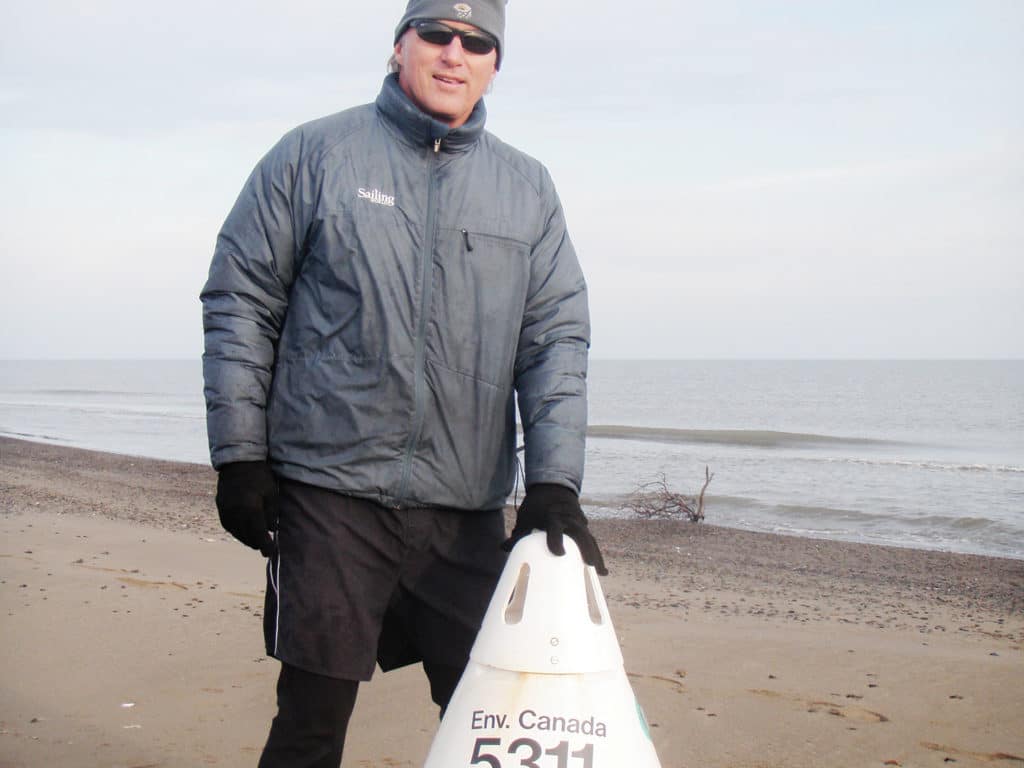
Aboard the 64-foot cutter Ocean Watch, en route to the Northwest Passage, we’d put the Bering Strait astern and were just miles away from crossing the Arctic Circle. First, we had a mission of sorts, to retrieve a weather buoy for a scientist at the University of Washington’s Applied Physics Lab that had beached itself on a remote barrier island; the drift buoy was now high and dry, but its satellite responder was working fine. We knew precisely where it was.
But just a few hours before we got there, we had an encounter that, a decade later, still makes my tummy flutter and my palms clammy. For that was the night we briefly ran aground off the tiny Alaskan village of Shishmaref, on its own flat barrier island flanking the Seward Peninsula. Earlier that very week, a BBC reporter described the place thusly: “It is thought to be the most extreme example of global warming on the planet.”
This we had to see for ourselves. It proved to be an iffy decision—you never want to kiss a sandy spit in the dead of night on a lee shore—but thankfully, not a tragic one. However, we hadn’t been drawn to Shishmaref because it’s a boomtown. Quite the opposite. It was a town going boom.
Shishmaref was in the news at the time for all the wrong reasons. Totally open to the north, it got sucker-punched by each successive winter storm. Warmer weather and water in the Arctic—not to mention melting permafrost—meant less protective ice, which translated to a shoreline exposed to wind and waves, which in turn eroded the tenuous beaches and cliffs. Everything along the foreshore was sliding into the sea, including the main road and a whole bunch of houses, which we could see on our approach.
It was just after midnight, the sea and sky a uniform slate of gray, but still fairly light outside in the high latitudes. There was activity along the beachfront, and after transmitting an open-ended call on the VHF inquiring about local knowledge, one of the villagers arrived on a skiff offering to guide us in. However, with our 9-plus-foot draft, it wasn’t to be. Suddenly we ground to a halt. There were some agonizing moments—what a sad way it would’ve been to dash our dreams—but eventually we powered off and carried on. The disappearing village vanished astern.
I was reminded of Shishmaref just before the new year after reading the results of the annual “Arctic report card,” a yearly assessment produced by the National Oceanic and Atmospheric Administration that, according to The New York Times, “takes a broad look at the effects of climate change in the region and compares current findings with the historical record.”
“If I had gotten a report card like this as a kid, I would’ve been grounded,” noted one professor. “It’s not showing much improvement at all. Things are getting worse.”
Where to begin? Rising temperatures. Thawing sea ice. Earlier-than-usual seasonal melts. Growing concerns over sea-level rises. Somehow, this very exact science has become politicized by many in the social media set, and elsewhere, but it’s quite real to the people living in the Arctic who have been dealing with the repercussions for decades now. Later fall freezes leave communities isolated; warmer waters mean you can’t travel over the ice; wildlife movements and patterns, the main source of sustenance through hunting and fishing for, like, eons, are disrupted. The distant tit-and-tat over the changing climate is kind of secondary when your stomach is growling. Young people raised in the Arctic are bailing in droves. Who could blame them?
Oh, about that melting permafrost, which sure has changed the real estate market in Shishmaref? It releases the carbon dioxide it traps into the atmosphere, spinning the cycle ever more rapidly. It’s all interconnected—a circle, a loop—and it’s not slowing down.
Back in Shishmaref, today, the 500 or so remaining residents are stuck between sticking it out or relocating to the mainland. It’s clear they’ll eventually need to leave, but tell that to a people with a history spanning, oh, 2,000 years or so. Talk about roots.
I never did set foot on Shishmaref; hours later, I was off on fresh adventures. That nice guy in the skiff who tried to help us out that night? In my rearview mirror, mate—not my problem. He’ll figure it out. Right?
Herb McCormick is CW’s executive editor.








